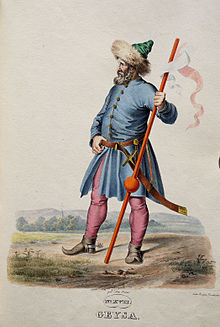Géza (Hungary)
Géza (* approx. 940; † February 1, 997 ), son of Grand Duke Taksony of Hungary and Grand Duke of Hungary from 971 to 997 from the Arpaden family .
Life
As heir to the throne, Géza stood as a military leader in 965 at the head of a Hungarian campaign that he undertook together with Bulgarian Tsar Peter against Byzantium . Shortly afterwards he led another campaign against Byzantium, this time together with the Kiev prince Svyatoslaw I. When this ended in 970 with a defeat at Arkadiopolis , the Hungarians gave up campaigns abroad for a long time.
At the same time, the Hungarians felt pressured from the west, since the reign in Bavaria ended in 967 and the young Heinrich “the brawler” had taken over the office of prince himself there. After he was made king in 971, Géza pushed ahead with the baptism efforts that had begun under his father. Shortly after taking office, he must have married Sarolt , the daughter of a nobleman who had already been baptized Orthodox. Géza asked for missionaries from the German Emperor Otto I. Otto then appointed the St. Gallen monk Brun as bishop for Hungary. In the autumn of 972 he arrived in his new area of responsibility and baptized Géza, whereupon a large part of the Hungarian nobility received the baptism. Through the Catholic baptism, Géza came closer to the west and dealt a severe blow to Byzantium's efforts to influence the Hungarians.
In terms of the internal structure of the Hungarian Empire, Géza continued his father's course. Géza had his supremacy recognized by the clan chiefs , confiscated large parts of their land and appointed governors in their castles. He chose Esztergom as his own seat . In addition, he further weakened the Hungarian warrior nobility by accepting fighters from other countries into his following. This included members of Turkish steppe peoples as well as nobles from southern Germany. In addition, he had a large part of the widely branched Arpaden clan and other influential clans killed, which opposed the centralization efforts, and thus limited the influence of the army assembly.
Shortly before his death, Géza cemented his final ties to the East Franconian-German Empire by arranging a marriage between his son Stephan I and the Bavarian princess Gisela (995), the sister of the future German king Heinrich II . This ended the armed conflict with Bavaria, which had led to fighting in the Vienna Basin in 991. Through his own second marriage (around 985) and the - albeit only brief - marriage of one of his daughters to Boleslaw of Poland , Géza wanted to expand Polish- Hungarian relations in order to compensate for the influence of the German king.
literature
- Miguel de Ferdinandy: Géza , in: Biographical Lexicon for the History of Southeast Europe . Vol. 2. Munich 1976, pp. 43-45
Web links
Remarks
- ↑ http://mek.oszk.hu/01900/01994/html/index1.html
- ↑ http://epa.oszk.hu/01500/01536/00006/pdf/UJ_1974_1975_024-037.pdf
| predecessor | Office | successor |
|---|---|---|
| Taksony |
Grand Duke of Hungary 971–997 |
Stephen the saint |
| personal data | |
|---|---|
| SURNAME | Géza |
| BRIEF DESCRIPTION | Grand Duke of Hungary, father of Stephan I. |
| DATE OF BIRTH | around 940 |
| DATE OF DEATH | 997 |

